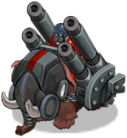

That is the end of the little horn.ĭaniel is troubled by the vision of the beast and the little horn, and he asks specifically about it (Daniel 7:19). thrown into the blazing fire” (verse 11). At that time, “the beast was slain and its body. The proud, boastful words of the little horn continue until the day of judgment (verses 9–10). Daniel sees that the little horn has “eyes like the eyes of a human being and a mouth that spoke boastfully” (Daniel 7:8). As it emerges, three of the original horns are plucked out by the roots. As he ponders the meaning of the horns, a little horn begins to grow from the midst of the ten. Daniel sees that the terrible beast has ten horns. This fourth beast has “bronze claws” (verse 19) and “large iron teeth” with which it annihilates its prey (verse 7). The fourth and final beast that Daniel sees is the most dreadful-“terrifying and frightening and very powerful” (Daniel 7:7). The first three beasts represent Babylon, Medo-Persia, and Greece. The prophet sees four beasts (Daniel 7:1–7) representing four kingdoms (verse 17). Fortunately for him and for us, the vision is explained.īefore we examine the little horn, we’ll take a quick look at the whole of Daniel’s vision. The emergence of the little horn, its unusual form, and its behavior cause Daniel to wonder greatly. In one of his visions, the prophet Daniel sees a “little horn” that grows out of a terrible beast (Daniel 7:8).


 0 kommentar(er)
0 kommentar(er)
